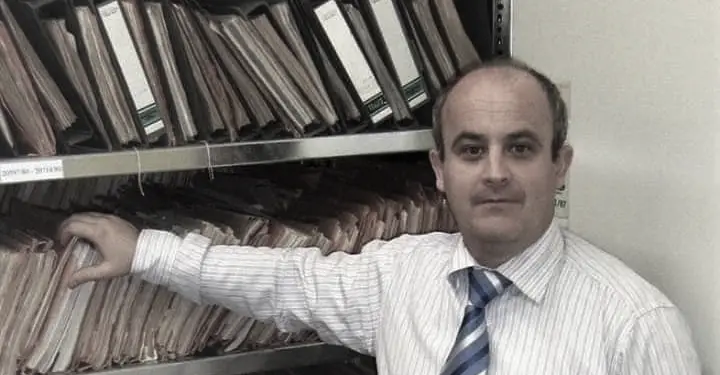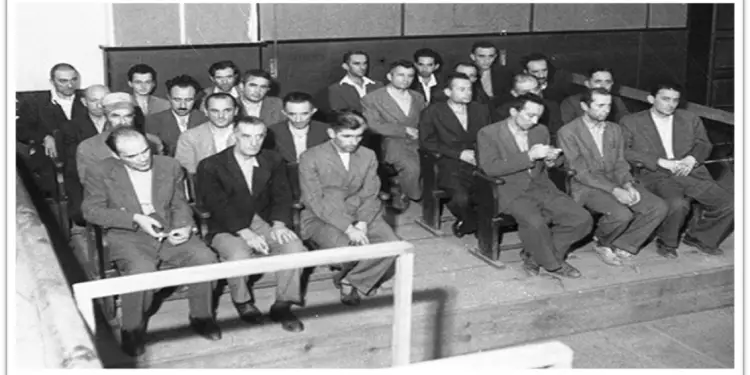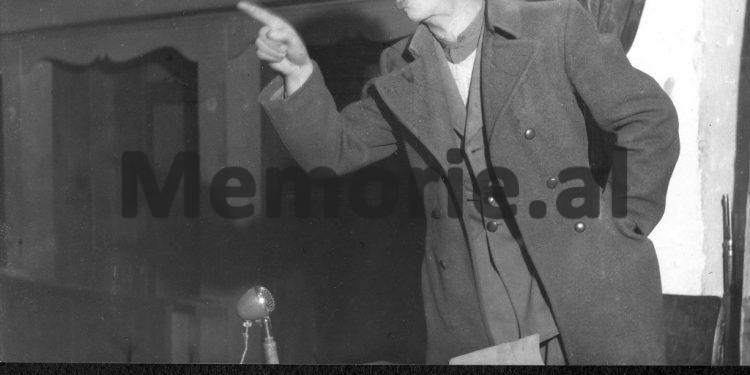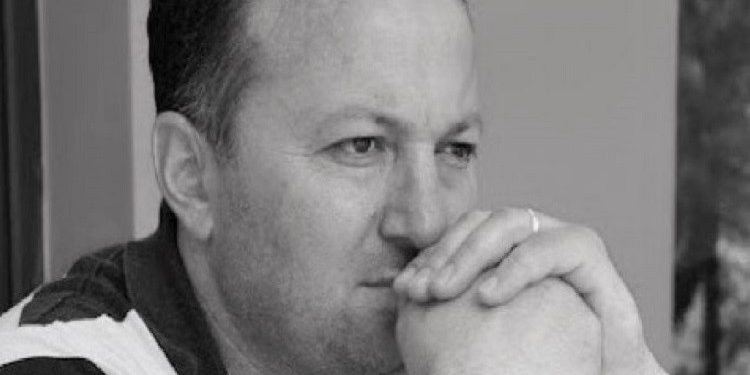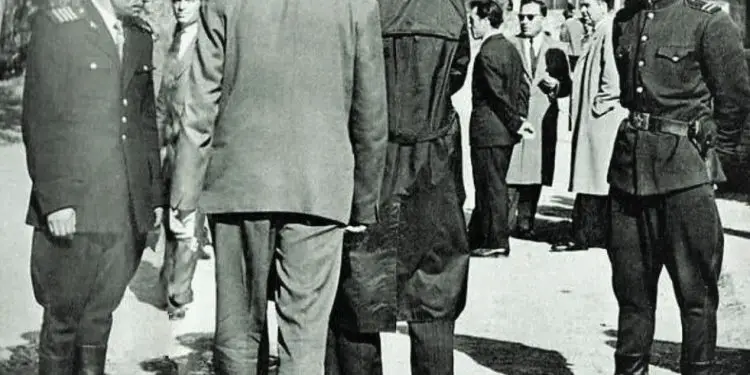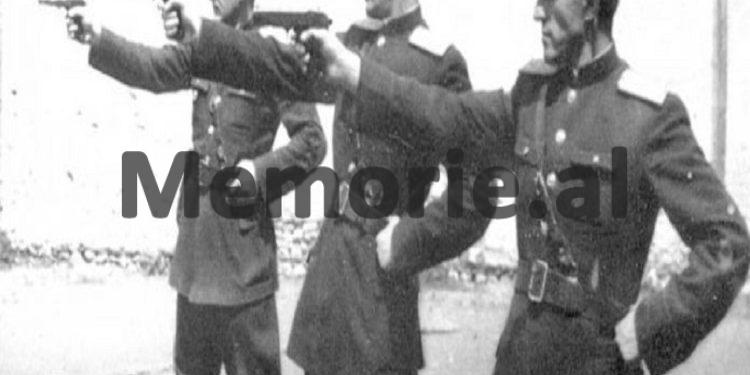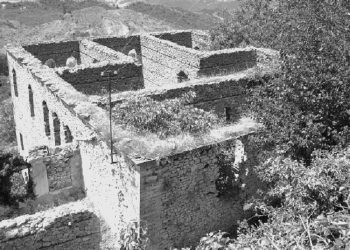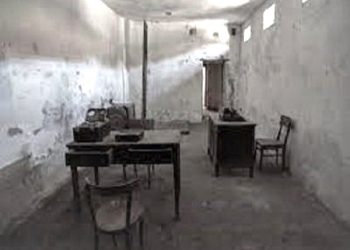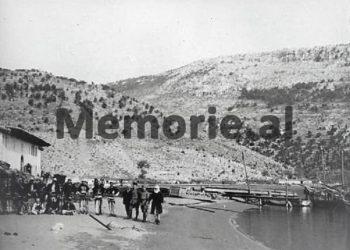By Ferdinand Dervish
The former director of the Archive of the Ministry of the Interior: “We have the exact names of the executioners of death sentences, such as the prosecutor, the doctor, the secretary, etc.”!
Memorie.al / “To go to the undiscovered burial sites of those shot during the communist era, we have the exact names of the prosecutors, investigators, doctors and secretaries who participated and assisted in these executions. They can serve as eyewitnesses; they can point to where the victims are buried.” This is the essence of the statements of the former Director of the Archives of the Ministry of the Interior, Kastriot Dervishi, during an exclusive interview regarding this topic, or rather a great wound of the entire Albanian society, which has not yet been closed. According to Dervish, there is not a single document in the archive that proves the location of the graves of the political executioners, but fortunately, a small number of sketches were found showing the graves of those executed for ordinary crimes.
In the same interview, Dervishi also tells about the places of executions during the communist era throughout the country and an order of the former Minister of the Interior, Kadri Hazbiu, for the compilation of maps of the locations, but which, unfortunately, time has made him invalid.
Mr. Dervishi, while you were working in the Ministry of Interior Archives, how did you respond to the requests of various citizens for help in finding the remains of their relatives who were shot during communism? How have you handled these cases?
Of course, finding the remains of people who were executed died in the investigation, in prison or in efforts with the State Security forces during the communist regime, has been one of the many requests that citizens have had to the Archives of the Ministry of the Interior. Not during this time, but already in the first years of democracy, requests were filed to find the remains of the persons in question. The readiness of the Archive has been maximal, putting to use everything that was in our archival funds. Not far from today (yesterday) the daughter of the executed O. I. came and was equipped with the practice of her father’s execution, accompanied by the last word where there was also a bequest with the daughter. The archive will make available to those interested everything it has and this is not discussed, but the essence of the materials deposited in it must be understood, since it is not a cemetery archive.
Since you had the opportunity to browse through the files from the time of communism, how was the documentation of the shootings handled? Have you seen accurate documents about the location of the graves, or names of people who participated in the firing squads, who can serve as eyewitnesses?
In the literal sense, there has not been any archival fund that I can call the “fund of executions”, or something close to them. We had to create and assemble everything from scratch. Some time ago, I started collecting shooting practices, from 1972 to 1990, and I can say that in a way, a unique archival fund has been created, using data from the funds of the Investigation and former Directorate of Enforcement of Criminal Decisions.
Meanwhile, other data are located separately in other funds, such as those of the Internal Affairs Branches, or within investigative – judicial files. Summarizing, I can say that most of the practices of executions exist, but without the outlines of the places where they are carried out.
According to the data of the AMB (Archive of the Ministry of the Interior. Ed.), there are 1030 people executed by the final decision of the communist courts, while together with the other categories. According to the compilation made by the relevant commission in 1992, it goes to 5,157 people.
Those executed by a final decision, after being sentenced by courts of different levels (first instance, Supreme Court, military courts, etc.), passed for final approval to the General Command of the Army (for military courts), or to Presidium of the People’s Assembly, for other cases.
Upon issuing the order (in the military cases of Enver Hoxha), or the decree from the Presidium of the People’s Assembly, approving the execution of the person, the Department of Internal Affairs of the district (in special cases the special group), where the case was tried, took order for decision execution. The order for the execution of the person was issued by the Minister of Internal Affairs. In this order, the relevant Branch was tasked to carry out the execution. Then the head of the branch drew up the plan of measures for this execution.
The documentation was compiled for the names of the persons who would participate in the execution (the prosecutor, the investigator, the doctor, the writing secretary, the commander of the execution group, the executioners, the persons who were trained to see the scene, to take heart, etc.). The minutes were completed with the last words spoken by the person sentenced to death, for the last time. In general, for politically convicted persons, the last words were for Albania, while for ordinary convicts (for murder, robbery, etc.), for the party and the leadership.
For the executions of the first years, due to the great amount of time that has passed, it is difficult to speak of living persons, while for the executions of the period from 1970 onwards; the possibility of the participants being alive is great. We have accurate data on prosecutors, investigators, doctors, secretaries, etc., who were present at an execution. There are also the data for the chairman and deputy chairman of the Internal Affairs Branch, who approved the plan of measures for execution.
Were burial site maps drawn up and how long were these documents kept by law?
After the processes of the first years, which proceeded without clear order, on January 10, 1947, decree no. 264 of the Presidium of the People’s Assembly, which promulgated the law no. 390, dated January 10, 1947; “On executions of sentences”? After three years, on February 9, 1950, the Minister of Internal Affairs, Mehmet Shehu, issued the order on the death sentences issued by the judicial bodies. According to this order, the punishment was given: after the final decision was given, as well as the decree of the Presidium of the People’s Assembly, after the written order of the minister was issued, the order was compiled by the 7th Branch of the State Security, when it had character political and from the police, when it had an ordinary character.
The order should contain: the person’s details, the number of the decision and the date of the court, the date, time and place of the execution, as well as who is charged with the execution, with the name, surname, rank and position. Minutes were made for each execution, where the last word of the condemned person was written. The minutes were sent to the branch where the order was drawn up, which sent it to the minister.
Later, another order of Kadri Hazbi came out, which more or less referred to the previous order. On the basis of this order, at that time sketches of the place where the executions were carried out were compiled, but the body implementing the order did not deposit these in the archive, as it considered; temporary operational document, with a 5-year storage period. Today we have in the Archive few sketches and burial places of the non-political executed, which were able to be deposited.
Were there designated places for the shooting of different categories of convicts, or was there only one? How did this work, in the different cities and districts of the country?
Each district had a place where executions were carried out. Don’t imagine that there were firing squads in front of convicted persons. At least in the last 20-30 years, this work was done by a trusted person just in case, with a bullet in the head, as bullets were not to be wasted. As for the places of execution, we can say something.
Several places were used for Tirana, such as; Kodra e Prifti (for the ‘Special Trial’ of 1945, etc.), Tirana River (Paskuqani area and the area called Peshkės, on the way to the village of Brar), Ura e Beshir (for the group of Hami Matjani and the “bomb in The Soviet Embassy”, some areas in Dajt (Linz), etc.
For Elbasan, Krasta and Muçani stream were used. For Durrës, Dajlani Bridge and Mount Robi were used. For Lushnja, a reservoir nears the city. For Korça, the road to Qafa e Qarri. For Vlora, the Soda Forest area, for Shkodra the area of antennas, for Peshkopi, a place in Drin e Black, etc. These places, for the most part, I have read, I have no idea how they can be.
Do you have approximate knowledge of how many groups of gunmen the bones have already been found and which time periods they belong to?
After 1992, there were numerous attempts to find the remains of the victims of communism. At that time, ceremonies were held to honor them. As far as I have been able to learn, most of the information was obtained on the ground, through eyewitnesses of the time. What has been discovered and found is certainly very little, compared to what is underground.
I have been in contact with many families who have been interested, while we have developed “investigations”, using the names that were mentioned in the minutes. Of course, it has been difficult, due to the years that have passed, people’s weak memory and the silence of the protagonists of that time, which seemed a great “privilege”, to provide relevant information.
Do you have data on demolition of burial sites from constructions made at different times?
Yes, this is the most painful issue. The constructions made before 1990, as well as those made after, have brought irreparable destruction of the graves. Thus, the “Mezin Well” area in Vlora, the “Tirana River” and “Priest’s Hill” areas in Tirana, for example, can be considered definitively lost cases.
Another problem is the dead buried in prisons, buried in public cemeteries, which are then moved. So, for example, burials were made in “Varrin e Bami”, in Tirana, and the remains were left there.
Have you come across any information about the bones found a while ago in the village of Qerret i Dajti?
I don’t know the exact name of this place, but I certainly know that it is one of the places used for executions.
Shootings, only the last words on file
In the secret archives of the Ministry of the Interior, precisely in the materials that have arrived undamaged to our days, there is a lack in any case of specifying the places where the gunmen of the communist era were buried. Officials of the Archives of the Ministry of the Interior claim that they have found a number of files of groups executed by firing squad during the communist period, but in no case in these documents were written, even a single word, about the place of burials, or location of mass graves.
In the files where there was more complete documentation, their last sheet, in the best case, has the names of the group in charge of the execution procedure, such as; the name of the commander of the firing squad, the name of the prosecutor and assistant investigator, the name of the doctor and a secretary. However, according to the same, such procedures were implemented mostly in the second part of the time of the communist regime, since in the first part, especially immediately after the liberation of the country, the documentation of executions by shooting is completely incomplete.
In these cases, only the name of the so-called was noted at the end of the document; “People’s Prosecutor”, and nothing more. So in no case was the place of burial noted, or even the names of the persons in charge of the shooting, who, in the absence of maps, could serve as eyewitnesses. The content of the following document, a 1945 execution in Korça, taken from the relevant trial file of a group of opponents of the communist regime, says nothing, except for the name of the prosecutor, who is no longer alive.
So the entire file, if someone were to look for a thread to arrive at the burial place of the three shot dead, there was only one name, which could be used to identify the grave. A name that, after death, no longer has any value for this purpose.
Archival document for the execution of three death row convicts in Korça in 1945
Military Judicial Council
No. Prot. 176. Res.
Korça, on 3/10/1945
Supreme Military Court, Tirana
In the evening of 2/10/1945, at 20:00, the criminals 1) Enver Agolli, 2) Rapo Zêmblaku, 3) Haki Nikolica were executed. The minute they got up from the prison, to get into the car and to be taken to the place of execution, the criminal Enver Agolli, amidst fear, shouted, addressing his friends who spared his life, Hasan Xamas of Shezai Train; “Goodbye Hasan, Goodbye Shezai”; these words were followed by Haki Nikolica and Rapo Zemblaku.
With such words, adding Rrofte Albania, they also addressed the prisoners, who had come out to watch from the windows of the prison rooms.
At the place of execution, before getting out of the car, the criminal Enver Agolli started shouting “down with communism” and the other criminal Haki Nikolica also said these words; while the third criminal Rapo Zemblaku did not say a word.
When they lined up and the partisans prepared to carry out the action, the last word was requested by the Prosecutor. Criminal Rapo Zëmblaku said: “Long live Albania, the government should take care of my child, because I also have a partisan son.”
Haki Nikolica asked the government to take care of his mother and sister; while the criminal Enver Agolli, shouting; “I have no words”, he cried; “down with communism”, and telling the comrades to run away, without the execution order being given, they, as the three were tied, tried to escape, and were put on the run.
At this time, a partisan, by order of the commander leading the platoon, wounded one of them, and the other two, unable to drag him away, stopped in place. The partisans approach and line up to perform the action. The partisans all laughed, although they shouted, calling, this time also Haki Nikolica; “Down with Communism”, while the criminal Enver Agolli, until he died, shouted: “I will pay Nevzati, I will pay Nevzati”. Nevzat was on their head and ordered fire on them.
Thus ended the criminals; Enver Agolli, Haki Nikolica and Rrapo Zëmblaku. Pardoning the life of the criminal Hasan Xama was well received by his circle, while the people felt the opposite. / Memorie.al
Death to Fascism – Freedom to the People
(People’s Prosecutor)
First Captain, Nevzat Haznedari
(Signature-Seal)





